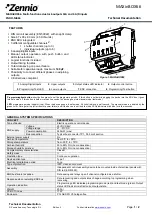
CNT-SVX04A-EN
Application information
86
When the master controller’s occupancy mode is communicated to one or more
slave controllers, the slave controllers echo the master’s occupancy mode,
including both On and Cancel requests. The controller interprets a momentary
fixed resistance (0.2–25 seconds) of 1.5 k
Ω
by the space temperature input as a
timed override Cancel request. During occupied bypass mode, the controller
uses a Cancel request to return the controller to unoccupied mode.
Setpoint operation
Controllers sharing information peer-to-peer (also referred to as master/slave)
can share a variety of data, including the heating/cooling setpoint
(communicated from a master to a slave).
Each controller derives its effective
setpoint and default setpoints (including
deadbands between setpoints) from the
setpoint input (hardwired or
communicated). To make sure the peer-to-
peer setpoint application results in
identical setpoints for each
communicating controller, each controller
must have exactly the same default
setpoints.
The stand-alone master controller derives its setpoint from either the local
hardwired setpoint input (if present) or from its default setpoints. Peer-to-peer
applications often require the use of one hardwired setpoint to be shared
across two or more controllers. You can achieve this by wiring the adjustable
setpoint (typically included as a part of the Trane zone sensor module) to one
controller—defined as the master. Next, use Rover to set up the master and one
or more slaves to share that setpoint. For this application, each communicating
controller uses the same setpoint.
Simplified peer-to-peer (master/slave) setup
To achieve synchronous unit operation in
master/slave setups, the master and slave
units should be the same unit type and
contain the same controller configuration.
To simplify setting up master/slave applications, the controller provides
information that groups all necessary shared data into one communication
variable (nvoMstrSlv3). This master/slave variable includes the following
information, which is communicated from the master to the slave to ensure
similar unit operation:
■
Space temperature
■
Setpoint
■
Heating/cooling mode
■
Occupancy
■
Fan speed
■
Entering water temperature
■
Economizer
■
Proprietary unit control algorithm coordination data
Use Rover service tool to set up peer-to-peer applications. Refer to the
Rover
Installation, Operation, and Programming
guide (EMTX-SVX01A-EN) for more
information on setting up applications.
















































